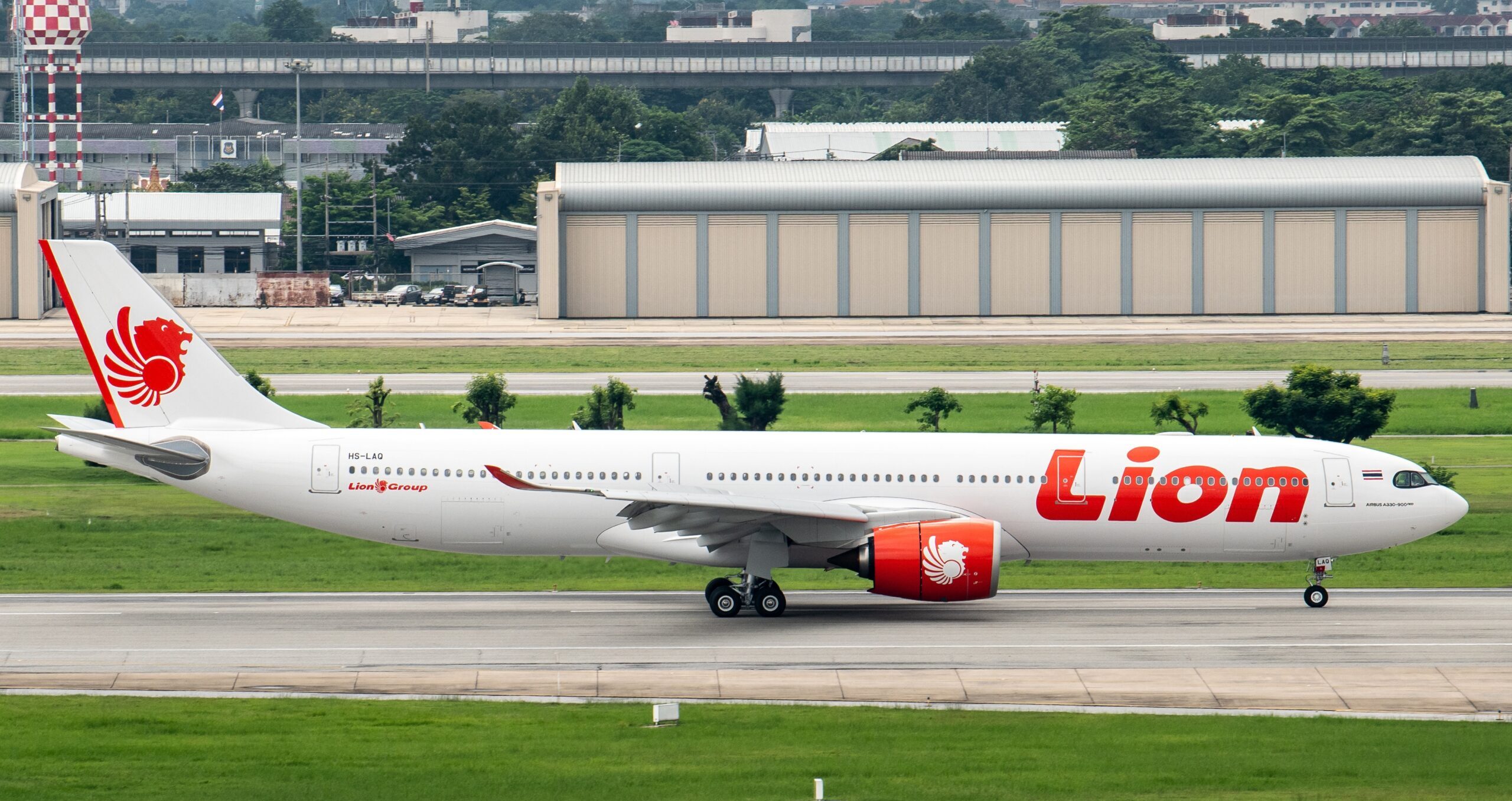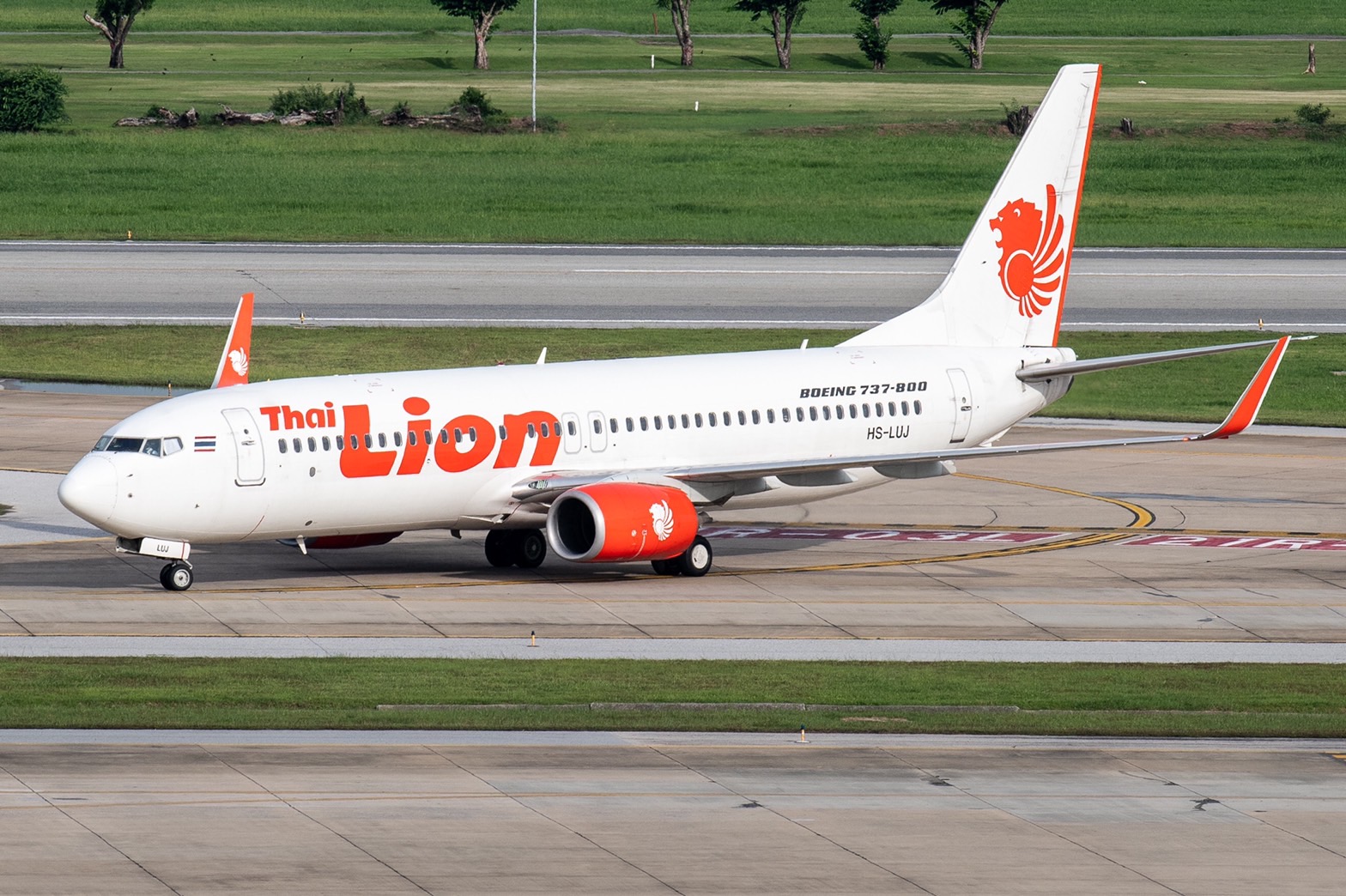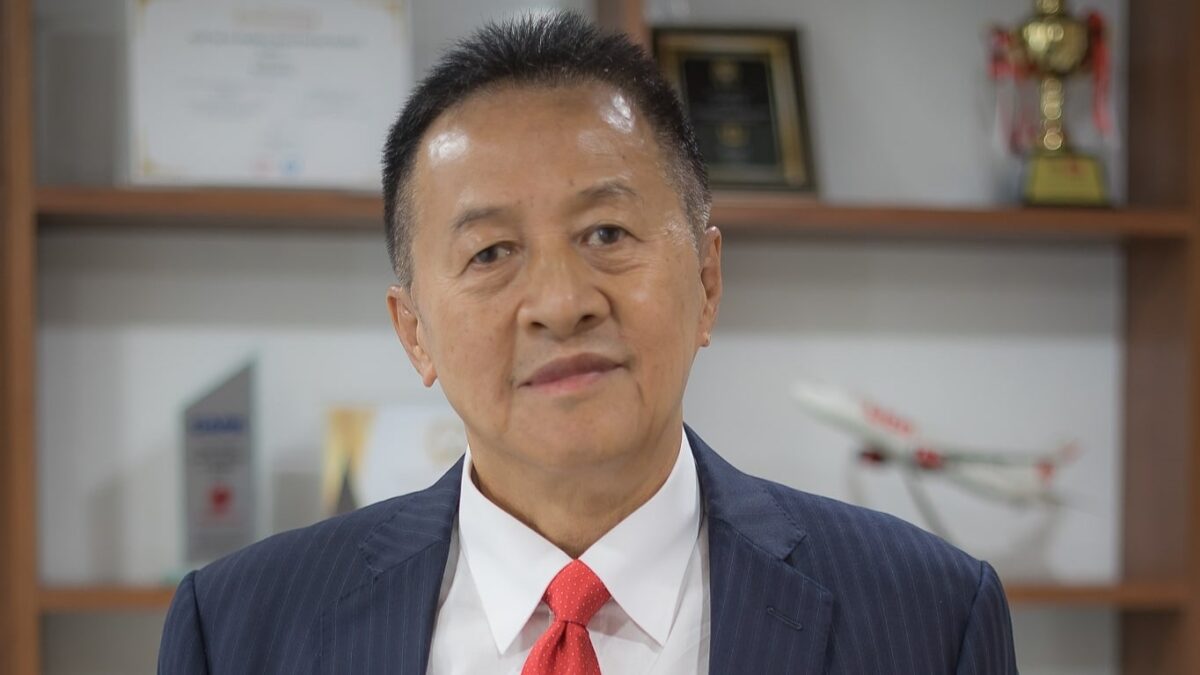EXCLUSIVE INTERVIEW: Thai Lion Air Taking Cautious Approach To Restoring Capacity
Note: Thai language version of article is lower down หมายเหตุ: บทความภาษาไทยอยู่ด้านล่าง
Thai Lion Air (TLA) is in no rush to actively restore services and resume vigorous growth, even though there is now rising demand for air travel with the easing of COVID-19 restrictions.
The Thai registered no-frills carrier remains cautious and has some concerns about whether the rebound in travel demand is sustainable enough to warrant a fast pace increase in capacity to pre-COVID levels.
The airline, under the umbrella of Indonesia’s Lion Group, views that it is better to be conservative in re-building its operations which were sharply scaled down over the past few years in response to the pandemic.
“Though there is a glimmer of revival [in air travel demand], we have to remain pragmatic about strenuously rebuilding the airline back to the pre-pandemic levels,” TLA chief executive, Aswin Yangkirativorn, tells the Smart Aviation Asia Pacific.
TLA’s stance is in sharp contrast with some of TLA’s budget rivals in Thailand, notably Thai AirAsia group which has responded enthusiastically – to Thailand and neighbouring countries’ easing of rules and inbound travel control measures – by restoring a large number of suspended services.
Aswin says: “There are several uncertainties preventing us from coming up with more concrete plans for expanding or planning too far ahead.
“We don’t know whether we can really put the COVID-19 issues behind us [and] if there will be another resurgence, with more detrimental effects that could deter travel sentiments, and again hit us.”
Then there is soaring jet fuel prices spurred by the Ukraine-Russia war with no sign of abating, a major factor that is weighing heavily on costs, Aswin notes.
Jet fuel prices recently jumped to around US$170 a barrel from just over US$80 towards the end of last year, figures from IATA show.
Like other carriers, ballooning fuel prices have complicated TLA’s move to spread its wings again, Aswin points out.
“We don’t need to follow others [in restoring operations], and we [will] not miss the train [of opportunities] as traffic demand is very unlikely to bounce back strongly and quickly.”
“But of course, we constantly review the market trends and adjust our operation accordingly to quickly respond to changes,” he adds.
Aswin is cautiously optimistic that there will be clearer picture in this year’s fourth quarter about the extent of the recovery, because by then all the remaining impediments to recovery in this region are likely to be completely abolished.
That would allow TLA to start reconsolidating the airline in a much more active manner.
Rebuilding
While TLA is adopting a conservative approach, since late last year it did begin to return aircraft to its fleet. TLA’s fleet shrunk by two-thirds, from the pre-pandemic levels, to number eight aircraft in September 2021.
But it took delivery of two Airbus A330neo widebody jets in last year’s fourth last quarter; the 9th and 10th aircraft in its fleet. Subsequently, it has added more Boeing 737-800s and 737-900s.
TLA today operates 11 737s and two A330s with two more Boeing 737s, either -800s or -900ERs, coming in the second-half, says Aswin.
Nuntaporn Komonsittivate, TLA head of commercial operations, says the carrier has resumed all its domestic routes and even introduced a new destination – the northern province of Nan, with eight scheduled flights a week starting in March.
However, TLA’s international flight resumption is occurring more slowly.
TLA, which first took to the skies in December 2013 on Bangkok-Chiang Mai route, is serving 15 Thai domestic airports today including its base which is Don Mueang International Airport (DMK) in Bangkok.
At present, TLA operates more than 40 domestic flights per day.
On May 1 this year it resumed regular services from Bangkok to Jakarta with three flights per week, marking the re-start of its international passenger operation.
It will be followed later this month by scheduled flights to Mumbai, Taipei and Singapore, says Nuntaporn.
Before the pandemic, TLA served 18 international destinations across six countries. China accounted for 14 destinations, making China the bulk of TLA’s international business.
Aswin says China still represents TLA’s most important source of foreign travellers but the airline has to reconcile with the fact China has a zero COVID policy, that is still very much in force, so the country is unlikely to re-open its border any time soon.
“But some changes for the better may happen in the second-half,” he adds.
A330neo as freighter
Since joining TLA’s fleet late last year, the two new A330neo aircraft have been used entirely as freighters, even though each is designed for carrying 436 passengers.

TLA’s new A330neo passenger jet is used for cargo (Photo: TLA)
These widebody Airbus aircraft, each capable of carrying 30-40t of cargo in the bellyhold, have generated much needed cargo revenue, while pent-up passenger demand is taking time to be realised, Aswin explains.
The two A330s are flying Thai durians and other fruits to China, specifically to Guangzhou, Kunming and Shanghai, and some general cargo to Jakarta, he says.
Nuntaporn says that once TLA completes its cargo contracts, the A330s will be used to fly passengers from Thailand to Japan and South Korea.
The airline had six A330s between 2017 and 2020 but these aircraft were then phased out when the pandemic hit Thailand.
Survival
TLA has survived the pandemic but has been losing money, confirms Aswin who declines to elaborate.
“We have undergone extreme cost controls and rationalisation that enabled us to survive,” he says.
TLA has now achieved a fairly good passenger load factor of 80% while its cargo side is doing quite well with the average aircraft utilisation being 9-10 hours per day, says Aswin.
“Let’s not talk about making profit for the time being, it may take several years before we can turn into the black,” Aswin states matter-of-factly.
Down the road, TLA aims to return to its heyday when it was operating a fleet of 30 aircraft and carrying more than 10 million passengers a year.
There are no plans to add more widebodies in the near term and 737s will remain the backbone of the airline’s operation, because it matches TLA’s business model, the TLA executives conclude.

Boeing 737-800: the workhorse of TLA (Photo: TLA)
Editor’s note: Thai Lion’s cautious approach to international route expansion may have to do with the fact that its international passenger business was heavily dependent on China, a market that remains closed to international travel. Prior to the pandemic, it was quite common for Thai Lion to take large tour groups from cities in China to Thailand and then onto Malaysia and Singapore and then back to China again. All the low-cost leisure carriers in Thailand were relying on the China market, but Thai Lion more so than others.
Featured photo TLA CEO Aswin Yangkirativorn: Taking cautious approach (Photo: TLA)
สัมภาษณ์พิเศษ: ไทยไลอ้อนแอร์ ระมัดระวังในการฟื้นฟูธุรกิจ
บุญส่ง โฆษิต
ไทยไลอ้อนแอร์ (TLA) ไม่รีบร้อนที่จะฟื้นฟูงานบริการอย่างเต็มที่ และกลับมาเติบโตอย่างอย่างกระฉับกระเฉงมากนัก แม้ว่าขณะนี้ความต้องการเดินทางทางอากาศจะเพิ่มขึ้นตามการผ่อนคลายข้อจำกัดของโควิด-19
โดยสายการบินต้นทุนต่ำของไทยนี้ยังคงระมัดระวัง และมีความกังวลว่าอุปสงค์การเดินทางจะฟื้นตัวได้อย่างยั่งยืนเพียงพอหรือไม่ที่จะรับประกันว่าจะควรเพิ่มขีดความสามารถอย่างรวดเร็วให้กลับไปสู่ระดับก่อนเกิดโรคระบาดใหญ่
สายการบินภายใต้เครือ Lion Group ของอินโดนีเซีย มองว่าควรนำเนินการแบบอนุรักษ์นิยมในการกลับมาฟื้นฟูการเติบโตอย่างแข็งขัน หลังจากที่ลดขนาดธุรกิจอย่างรุนแรงในช่วงสองสามปีที่ผ่านมาเพื่อรับมือกับโรคระบาด
“แม้ว่าจะเริ่มเห็นการฟื้นตัวในความต้องการการเดินทางทางอากาศ แต่เรายังคงต้องรอบคอบอย่างยิ่งกับการสร้างสายการบินใหม่ให้กลับสู่ระดับก่อนเกิดโรคระบาด” อัศวิน ยังกีรติวร ประธานเจ้าหน้าที่บริหารของ TLA กล่าวกับ Smart Aviation Asia Pacific
จุดยืนของ TLA นั้นตรงกันข้ามกับสายการบินคู่แข่งของ TLA บางรายในประเทศไทย โดยเฉพาะกลุ่มไทยแอร์เอเชียที่ตอบสนองอย่างกระตือรือร้น ต่อการผ่อนคลายกฎเกณฑ์ และมาตรการควบคุมการเดินทางขาเข้าของประเทศไทย และประเทศเพื่อนบ้าน โดยฟื้นฟูบริการที่ถูกระงับเป็นอย่างมากในช่วงก่อนนี้
อัศวินกล่าวว่า: “มีความไม่แน่นอนหลายประการที่ขัดขวางไม่ให้เราคิดแผนที่เป็นรูปธรรมมากขึ้นสำหรับการขยาย หรือวางแผนล่วงหน้ามากเกินไป
“เราไม่รู้ว่าเราจะทิ้งปัญหาโควิดไว้ข้างหลังได้แล้วจริงๆหรือไม่ [และ] จะมันจะฟื้นคืนชีพอีกหรือไม่ ซึ่งถ้าเป็นเช่นนั้นจะส่งผลเสียมากกว่าที่อาจขัดขวางอารมณ์ในการเดินทางของผู้คน และกระทบกระเทือนเราอีกครั้ง”
และยังมีประเด็นราคาน้ำมันเครื่องบินที่พุ่งสูงขึ้นจากสงครามยูเครน-รัสเซีย โดยที่ยังไม่มีทีท่าว่าจะลดน้อยลง ซึ่งเป็นปัจจัยสำคัญที่ถ่วงต้นทุนอย่างหนัก เขาตั้งข้อสังเกต
ตัวเลขจากสมาคมการขนส่งทางอากาศนานาชาติ (IATA) แสดงว่าราคาน้ำมันเครื่องบินพุ่งขึ้นเป็นประมาณ 170 ดอลลาร์สหรัฐฯ ต่อบาร์เรลเมื่อเร็ว ๆ นี้จากระดับ 80 ดอลลาร์สหรัฐฯ ในช่วงปลายปีที่แล้ว
เช่นเดียวกับสายการบินอื่นๆ ราคาน้ำมันที่พุ่งสูงขึ้นทำให้ TLA สยายปีกปีกอีกครั้งได้ยากขึ้น อัศวินชี้ให้เห็น
“เราไม่จำเป็นต้องปฏิบัติตามผู้อื่น [ในการดำเนินการฟื้นฟู] และเราคงจะไม่พลาดรถไฟ [ของโอกาส] เนื่องจากความต้องการการจราจรไม่น่าจะกลับมาอย่างรวดเร็วและรุนแรง”
“แต่แน่นอนที่สุด เราคอยตรวจสอบแนวโน้มของตลาดอย่างต่อเนื่อง และปรับการดำเนินการของเราตามนั้น เพื่อตอบสนองต่อการเปลี่ยนแปลงอย่างรวดเร็ว” เขากล่าวเสริม
อัศวินมองโลกในแง่ดีอย่างระมัดระวังว่าจะมีภาพที่ชัดเจนขึ้นในไตรมาสที่สี่ของปีนี้เกี่ยวกับขอบเขตของการฟื้นตัว เนื่องจากเมื่อถึงเวลานั้น อุปสรรคที่เหลือทั้งหมดในการฟื้นตัวในภูมิภาคนี้มีแนวโน้มที่จะถูกยกเลิกโดยสิ้นเชิง
ซึ่งจะทำให้ TLA สามารถเริ่มต้นการเสริมสร้างสายการบินในลักษณะที่กระฉับกระเฉงมากขึ้น
การสร้างใหม่
ในขณะที่ TLA ได้ใช้แนวทางแบบอนุรักษ์นิยม โดยตั้งแต่ปลายปีที่แล้ว TLA ได้เริ่มนำเครื่องบินกลับคืนสู่ฝูงบินที่หดตัวลงสองในสามจากระดับก่อนเกิดโรคระบาดเหลือเป็น แปดเครื่องในเดือนกันยายนปีที่แล้ว
แต่ TLA ได้รับมอบเครื่องบินเจ็ตลำตัวกว้างแอร์บัส A330neo จำนวน 2 ลำในไตรมาสที่สี่ของปีที่แล้ว นับเป็นเครื่องบินลำที่ 9 และ 10 ในฝูงบิน และต่อมาได้เพิ่มเครื่องโบอิ้ง 737-800 และ 737-900 เพิ่มเติม
ปัจจุบัน TLA ให้บริการ เครื่องบินแบบ 737 จำนวน 11 ลำและ A330 อีก 2 ลำ โดยมีแผนนำโบอิ้งรุ่น 737-800 และ หรือ 737-900ER อีกทั้งหมด 2 ลำมาให้บริการในช่วงครึ่งหลังของปีนี้ อัศวิน กล่าว
นันทพร โกมลสิทธิเวช หัวหน้าฝ่ายปฏิบัติการเชิงพาณิชย์ของ TLA กล่าวว่า สายการบินได้กลับมาให้บริการเส้นทางภายในประเทศเดิมทั้งหมดแล้ว และยังแนะนำจุดหมายปลายทางใหม่อีก นั่นคือ จังหวัดน่าน โดยมี 8 เที่ยวบินต่อสัปดาห์ เริ่มตั้งแต่เดือนมีนาคมที่ผ่านมา
อย่างไรก็ตาม การเริ่มต้นเที่ยวบินระหว่างประเทศของ TLA นั้นเกิดขึ้นช้ากว่า
TLA ซึ่งบินขึ้นสู่ท้องฟ้าครั้งแรกในเดือนธันวาคม 2556 บนเส้นทางกรุงเทพฯ-เชียงใหม่ ให้บริการสนามบินภายในประเทศ 15 แห่งในปัจจุบัน รวมทั้งฐานปฏิบัติที่ท่าอากาศยานนานาชาติดอนเมือง (DMK) ในกรุงเทพฯ
ปัจจุบัน TLA ให้บริการเที่ยวบินภายในประเทศมากกว่า 40 เที่ยวบินต่อวัน
เมื่อวันที่ 1 พฤษภาคม ปีนี้ ทางสายการบินได้กลับมาให้บริการตามปกติจากกรุงเทพฯ สู่จาการ์ตา โดยมี 3 เที่ยวบินต่อสัปดาห์ นับเป็นการเริ่มให้บริการผู้โดยสารระหว่างประเทศอีกครั้ง
และจะตามมาในปลายเดือนนี้ด้วยเที่ยวบินไปมุมไบ และไทเป และสิงคโปร์ในช่วงต่อไป นันทพรกล่าว
ก่อนเกิดการระบาดใหญ่ TLA ให้บริการปลายทางระหว่างประเทศ 18 แห่งในหกประเทศ โดยประเทศจีนมีจุดหมายปลายทาง 14 แห่ง ทำให้จีนเป็นธุรกิจระหว่างประเทศหลักของ TLA
อัศวินกล่าวว่าจีนยังคงจะเป็นตลาดนักเดินทางที่สำคัญที่สุดของ TLA แต่สายการบินต้องได้รับกระทบกับโยบายโควิดเป็นศูนย์ของจีน ซึ่งยังคงมีผลบังคับใช้อย่างต่อเนื่อง ดังนั้นประเทศไม่น่าจะเปิดพรมแดนอีกครั้งในเร็วๆ นี้
“แต่การเปลี่ยนแปลงบางอย่างในทางที่ดีขึ้นอาจเกิดขึ้นในช่วงครึ่งปีหลัง” เขากล่าวเสริม
A330neo ใช้เป็นเครื่องบินขนส่งสินค้า
นับตั้งแต่เข้าร่วมฝูงบินของ TLA เมื่อปลายปีที่แล้ว เครื่องบิน A330neo ใหม่ 2 ลำได้ถูกใช้เป็นเครื่องบินขนส่งสินค้าโดยสิ้นเชิง แม้ว่าแต่ละลำจะได้รับการออกแบบสำหรับบรรทุกผู้โดยสารได้ 436 คนก็ตาม

เครื่องบินโดยสาร A330neo รุ่นใหม่ของ TLA ใช้สำหรับการขนส่งสินค้า (ภาพ: TLA)
เครื่องบินแอร์บัสลำตัวกว้างเหล่านี้ ซึ่งแต่ละลำสามารถบรรทุกสินค้าได้ 30-40 ตันในใต้ท้อง สร้างรายได้จากการขนส่งสินค้าที่จำเป็นอย่างมาก ในขณะที่ความต้องการของผู้โดยสารที่ถูกกักไว้นั้นต้องใช้เวลาในการตอบสนอง อัศวิน อธิบาย
A330 ทั้งสองถูกใช้ขนทุเรียนไทยและผลไม้อื่นๆ ไปยังประเทศจีน โดยเฉพาะไปยังกวางโจว คุนหมิง และเซี่ยงไฮ้ และขนส่งสินค้าทั่วไปบางส่วนไปยังจาการ์ตา เขากล่าว
นันทพรกล่าวว่าเมื่อ TLA เสร็จสิ้นสัญญาขนส่งสินค้าแล้ว A330 จะถูกนำมาใช้ในการบินผู้โดยสารจากประเทศไทยไปยังญี่ปุ่นและเกาหลีใต้
สายการบินเคยมีเครื่องบิน A330 จำนวน 6 ลำระหว่างปี 2017 ถึง 2020 แต่เครื่องบินเหล่านี้ถูกยกเลิกเมื่อเกิดโรคระบาดในประเทศไทย
เอาชีวิตรอด
TLA รอดชีวิตจากการระบาดใหญ่ แต่ยังขาดทุนอยู่ อัศวินบอก แต่ปฏิเสธที่จะให้รายละเอียดเพิ่มเติม
“เราได้ผ่านการควบคุมต้นทุนอย่างสุดโต่ง และปรับขนาดองค์กร และการปฏิบัติงานให้เหมาะสมตามสถานการณ์ที่ลำบากนัก ซึ่งทำให้เราสามารถอยู่รอดได้” เขากล่าว
ปัจจุบัน TLA ประสบความสำเร็จในเรื่องอัตราการบรรทุกผู้โดยสาร (load factor) ที่ค่อนข้างดีถึง 80% ในขณะที่ด้านสินค้าบรรทุกนั้นก็ทำได้ดีทีเดียว โดยการใช้เครื่องบินโดยเฉลี่ยอยู่ที่ 9-10 ชั่วโมงต่อวัน
“อย่าพูดถึงการทำกำไรในตอนนี้ อาจต้องใช้เวลาหลายปีกว่าที่เราจะเห็นกลายจากตังแดงเป็นดำ” อัศวินกล่าวตามความเป็นจริง
ในระยะต่อไป TLA ตั้งเป้าที่จะหวนคืนสู่ความรุ่งเรืองในอดีต ซึ่งมีเครื่องบินให้บริการ 30 ลำและบรรทุกผู้โดยสารมากกว่า 10 ล้านคนต่อปี
ผู้บริหารของ TLA ได้สรุปว่า เครื่องบินรุ่น 737 จะยังคงเป็นยานพาหนะหลักของการดำเนินงานของสายการบิน เนื่องจากเครื่องบินรุ่นนี้สอดคล้องกับรูปแบบธุรกิจของ TLA

โบอิ้ง 737-800: ตัวจักรหลักของ TLA (ภาพ: TLA)
อัศวิน ยังกีรติวร ซีอีโอ ของ TLA: กลับมาโตอย่างระมัดระวัง (ภาพ: TLA)

